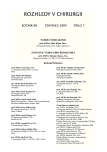Septic Shock in a Patient with the Fourniér Gangrene with Fatal Outcome
Authors:
P. Zonča; T. Mrázek; A. Matušek; Hájek M.. Štiglerová S. 1 1; A. Jurytko; C. Kučera 1; M. Nieslanik 2
Authors‘ workplace:
Chirurgické a traumatologické oddělení, MN Ostrava, primář: MUDr. T. Mrázek, Ph. D.
; Oddělení ARO, pracoviště Hyperbarické komory, MN Ostrava, primář: MUDr. C. Kučera
1; Oddělení patologie, MN Ostrava, emeritní primář: MUDr. M. Nieslanik
2
Published in:
Rozhl. Chir., 2009, roč. 88, č. 7, s. 398-402.
Category:
Monothematic special - Original
Overview
Aim:
The authors present a case of a patient with developed Fourniér gangrene and septic shock. Fourniér gangrene belongs to the group of local non-specific infection of soft tissues (NSTI). Its incidence is relatively low, but the infection is extraordinary aggressive with a possible lethal end.
Material and Method:
39 years old patient with 4 days history of Fournier gangrene’s development was admitted in irreversible septic shock. The initial APACHE II score was 36. The delay in treatment was an important factor in the further course of illness with lethal end.
Results:
Above the mentioned 39 years old patient died because of septic shock. The hemorrhagic cystitis was the original source of infection with further development of Fourniér gangrene according to the pathological record.
Conclusion:
We often come across all different kinds of stages of sepsis from the MODS to the septic shock for patients with Fourniér gangrene. Causal treatment should be started early. The local surgical excision and wide broad antibiotic administrations are basic treatments in the context of other treatment modalities according to the current patient’s needs. The adjuvant hyperbaric oxygen treatment takes place in patients with Fourniér gangrene as well and is beneficial. The following factor even worsens the illness prognosis: delay in diagnostic, higher age, anorectal origin of infection, the amount of organ with dysfunction or failure, diabetes mellitus and significant immunodeficiency.
Key words:
Fourniére – gangrene – focal – NSTI – sepsis
Sources
1. Smith, G. L., Bunker, C. B., Dinneen, M. D. Fourniér gangrene. Br. J. Urol., 1998, 81: 347–355.
2. Fournier, J. A. Gangrene foudroyante de la verge. Medecin Pratique, 1883, 4: 589–597.
3. Meleney, F. L. Hemolytic streptococcus gangrena. Arch. Surg., 1924, 9, 317–364.
4. Stephens, B. J., Lathrop, J. C., Rice, W. L., Gruenber, J. C. Fourniér‘s gangrene, historic (1764–1978) versus contemporary (1979–1988) differences in etiology and clinical importace. Am. Surg., 1993, 59, 149–154.
5. Tripathi, F. M., Khanna, N. N., Venkateshwarlu, V., Sinha, J. K. Gangrene of the scrotum: a series of 20 cases. Br. J. Plast. Surg., 1978, 31: 242–243.
6. Baskin, L. S., Dixon, C., Stoller, M. L., Carroll, P. R. Pyoderma gangrenosum presenting as Fourniér‘s gangrene. J. Urol., 1990, 144, 984–986.
7. Ersay, A., Yilmaz, G., Akgun, Y., Celik, Z. Factors Affecting Mortality of Fourniér’s Gangrene, Review of 70 Patients. ANZ J. Surg., 20007, 77 (1–2), 43–48.
8. Elliott, D., Kucera, J. A., Myers, R. A. The Microbiology of Necrotizing Soft Tissue Infections. Am. J. Surg., 2000, 179(5), 361–366.
9. Clayton, M. D., Fowler, J. E. jr., Sharifi, R., Pearl, R. K. Cause, presentation and survival of fifty-seven patients with necrotizing fasciitis of the male genitalia. Surg. Gynecol. Obstet, 1990, 170, 49–55.
10. Veselský, Z., Macek, P., Rýdel, L., Prošvic, P., Förstl, M., Plíšek, S. Fourniérova gangréna. Rozhl. Chir., 2002, 81 (7), 357–359.
11. Eke, N. Fourniér‘s gangrena, the Nigerian experience. Nig. Postgrad. Med. J., 1999, 6, 99–102.
12. Matušek, A., Martínek, L., Chmelař, D., Krásová, Z. Fourniérova gangréna. Rozhl. Chir., 1998, 77(1), 24–26.
13. Hollabaugh, R. S., Dmochowski, R. R., Hickerson, W. L., Cox, C. E. Fourniér‘s gangrene: therapeutic impact of hyperbaric oxygen. Plast. Reconstr. Surg., 101, 94, 1998.
14. Wong, C., Chang, H., Pasupathy, S., Khin, L., Tan, J., Low, C. Necrotizing fasciitis: clinical presentation, mikrobiology, and determinants of mortality. JBJS 2003, 85, 1454–1460.
15. Martin, G. S., Mannino, D. M., Baton, S., Moss, M. The epidemiology of sepsis in the United States from 1979 through 2000. N. Engl. J. Med., 2003, 348: 1546–1554.
16. Alberti, C., Brun-Buisson, C., Burchardi, H., et al. Epidemiology of sepsis and infection in ICU patients from an international multicentre kohort study. Intensive Care Med., 2002, 28: 108–121.
17. ACCP/SCCM Consensus Conference Committee. Definition for sepsis and organ failure and guidelines for the use of innovative therapies in sepsis. Crit. Care Med., 1992, 20: 864–874.
18. Kaiser, R. E., Cerra, F. B. Progressive necrotizing surgical infections – a unified approach. J. Trauma, 1981, 21, 349–355.
19. Harbarth, S., Ferriere, K., Hugonnet, S., Ricou, B., Suter, P., Pittet, D. Epidemiology and prognostic determinant of bloodstream infections in surgical intensive care. Arch. Surg., 2002, 137, 1353–1359.
20. Dellinger, R. P., Carlet, J., Masur, H., et al. Surviving Sepsis Campaign for management of severe sepsis and septic shock. Crit. Care Med., 2004, 32, 858–872.
21. Rivers, E., Nguyen, B., Havstad, S., et al. Early goal-directed therapy in the treatment of severe sepsis and septic shock. N. Engl. J. Med., 2001, 345, 1368–1377.
22. Meier-Hellmann, A. Hamodynamische Stabilisierung in der Sepsis. Anasthesiologie et Intensivmedizin, 2000, 41, 601–613
Labels
Surgery Orthopaedics Trauma surgeryArticle was published in
Perspectives in Surgery

2009 Issue 7
Most read in this issue
- Septic Shock in a Patient with the Fourniér Gangrene with Fatal Outcome
- Complications of IPOM Plasty – Our Experience
- The Complication of a Periproctal Abscess – Fourniér’s Gangrene or Necrotizing Fasciitis? A Case Report
- Anti- biotic Prophylaxis in Urology
